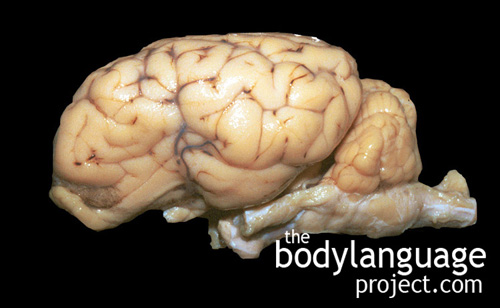The limbic system is a set of brain centers including the amygdale, hippocampus, anterior thalamic nuclei, and limbic cortex. These structures in collection handle emotion, behavior, long term memory and olfaction or the sense of smell. In 1952 researcher Paul MacLean started using terms to divide the brain by function and what he thought was their origin. He called collections of the brain the “reptilian brain” which included the base of the brain and brain stem, the “mammalian brain” or the limbic brain and the “neocortex” or human brain. Scientists have proposed that the brain has evolved from a primitive reptilian brain to the more complex neocortex. By examining images of the brain, it become apparent to scientists that the brain has “stacked” specialized structure upon specialized structure in what seems like a progress through time. Think of how rocks form through sedimentation over time, and you have a rough idea of how brains have evolved. By moving inwards from the outer layers of the brain to the center it has been theorizes that one is moving back in time to the original “primitive” brain. This is why the center brain is called the reptilian (original, less complex) brain whereas the neocortex (“neo” meaning new, more complex) which the mammalian brain, is located on the outside.
As it applies to nonverbal behaviour, it is the limbic brain that is responsible because it reacts naturally to the world around us, and the stimulus it contains. Behaviours produced by the limbic brain, over say behaviours that are controlled by the neocortex, are a true honest response. In other words, the limbic brain controls emotional body language so it’s our best gauge to indicate what the body is really feeling. It is the limbic brain that controls the arms, feet, hands, heads, and torsos when someone is feeling embarrassed or ashamed, sad, fearful, excited or happy. The limbic brain is hardwired into our nervous system and goes back in time with us through our evolution.
While our neocortex can at times suppress the limbic brain, it can only do so when it is no occupied doing other things. The neocortex is in charge of doing complex conscious tasks (like calculus, engineering, and so forth), so when it is overwhelmed or turned off entirely, the body accidentally leaks emotional body language for others to read. The neocortex, because it is under conscious control, is the least reliable and least honest part of the brain. Research shows that the neocortex is the most active part of the brain during deception which is why it has been called the “lying brain.” Cheats might be able to control the words they use to describe their thoughts, but they can’t control their visceral reactions to these words, nor can they control their expressions stemming from this motivation. This is exactly how and why we can catch liars, read fear, stress, sadness, anger and so on.

Turtling is a limbic response to confrontation. The head sinks, shoulders shrug, and the body takes on a smaller form to avoid being seen as a threat.
When you think of the limbic brain imagine the autonomic response that happens when we are startled by a loud bang. Naturally our bodies tense up, our heads duck into our torsos and our hands are pulled inward while our nervous system puts our heart into high gear through a dose of adrenaline. It is the same part of the brain that makes the feet fidget or hands shake when excited, or makes our hands sweat when under pressure. Our limbic brain also goes into hyper-drive when we see a distant relative after years apart, or when someone wins the lottery or gets a strong hand in poker. No matter what we do, we can’t stop this from happening. I will add too, that with some practice we can learn to hide, or minimize even these reptilian behaviours such as clasping the hands together to reduce shaking when excited, or tucking the legs in behind a chair to lock them in place when someone really wants to flee. However, even this body language shows the neocortex trying to override the reptilian brain and in so doing producing yet another stream of body language for us to read. At the scene of an accident we fully expect to see the limbic system take over producing trembling, nervousness, and discomfort. What would First Responders be left thinking if they showed up at an “accident” where the caller was relaxed and calm, yet the victim lay strewn about, dying and bloodied? Naturally, the police would think something was amiss and would pull the witness aside as a prime suspect for a crime. Therefore, we should always look for limbic responses and tie them to context so we know when something is not right. When limbic responses stop, we know that the stimulus for their creation has also stopped, so we must then find out the reason.
The limbic brain is the part of the brain that controls our root processes. To put this into perspective, imagine the activities in the repertoire of a lizard. Being cold blooded, he seeks sun when possible to speed up his metabolism, eats when hungry, drinks when thirsty, either freezes, flees, or fights when scared, and has sex when horny. He does not do calculus or engineer tall skyscrapers because he does not have the capacity, but this notwithstanding; he survives, because his limbic mind tells him everything necessary to do so. In evolutionary terms, so too does our limbic mind. It tells us when to be scared and what to do about it, be it freeze and reduce movement so as to get under the radar of assailants, to run and so get our feet pointed in the right direction, to get our hearts pumping to run and so on. It also controls root emotions – it tells our feet to move and jump with joy, and fidget in preparation to leave when bored.
Above: Technical view of the lymbic system.








